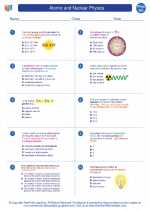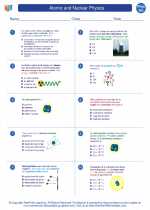Linear Motion
Linear motion is the most basic form of motion. An object is said to be in linear motion if it moves along a straight path. The study of linear motion forms the foundation of many concepts in physics and engineering.
Key Concepts:
- Speed and Velocity: Speed is the measure of how fast an object is moving, while velocity includes the direction of the motion.
- Acceleration: Acceleration is the rate at which an object's velocity changes over time. It can be positive (speeding up) or negative (slowing down).
- Distance and Displacement: Distance is the total length of the path traveled by an object, while displacement is the shortest distance between the initial and final positions, including direction.
- Equations of Motion: Equations such as v = u + at, s = ut + 0.5at^2, and v^2 = u^2 + 2as, where v is final velocity, u is initial velocity, a is acceleration, t is time, and s is displacement, are used to describe linear motion mathematically.
- Graphical Analysis: Graphs of position-time, velocity-time, and acceleration-time can be used to analyze an object's linear motion.
Study Guide:
When studying linear motion, it's important to understand the following key points:
- Define and differentiate between speed and velocity.
- Understand the concept of acceleration and how it relates to changes in velocity.
- Be able to calculate distance, displacement, speed, velocity, and acceleration using appropriate formulas.
- Interpret and analyze position-time, velocity-time, and acceleration-time graphs to extract information about an object's motion.
- Apply the equations of motion to solve problems related to linear motion.
Practicing numerical problems and graph interpretations will help reinforce your understanding of linear motion. Additionally, real-life examples of linear motion, such as motion of vehicles, projectiles, and pendulums, can provide practical insights into the concept.
Understanding linear motion is essential for grasping more advanced topics in physics, such as projectile motion, circular motion, and oscillations.
[Linear Motion] Related Worksheets and Study Guides:
.◂Physics Worksheets and Study Guides High School. Atomic and Nuclear Physics
Worksheet/Answer key Atomic and Nuclear Physics
Atomic and Nuclear Physics  Worksheet/Answer key
Worksheet/Answer key Atomic and Nuclear Physics
Atomic and Nuclear Physics  Worksheet/Answer key
Worksheet/Answer key Atomic and Nuclear Physics
Atomic and Nuclear Physics  Worksheet/Answer key
Worksheet/Answer key Atomic and Nuclear Physics
Atomic and Nuclear Physics 

 Worksheet/Answer key
Worksheet/Answer key
 Worksheet/Answer key
Worksheet/Answer key
 Worksheet/Answer key
Worksheet/Answer key

The resources above cover the following skills:
PHYSICAL SCIENCE
Matter and Its Interactions
Develop models to illustrate the concept of half-life for radioactive decay.
Research and communicate information about types of naturally occurring radiation and their properties.